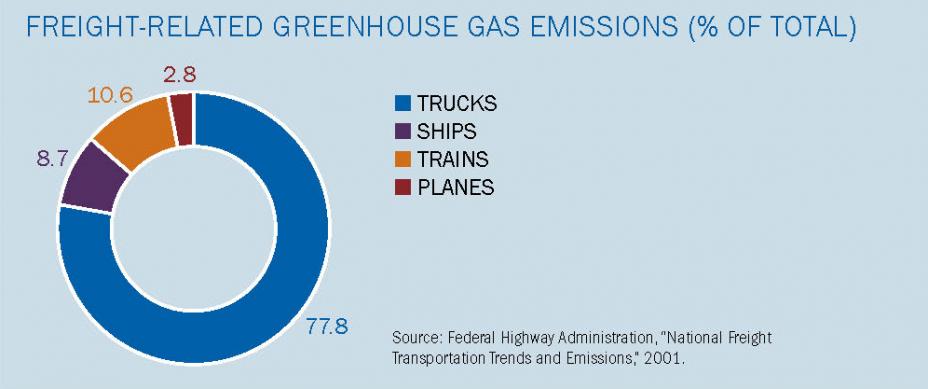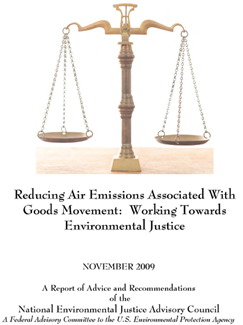Ports Primer: 5.3 Potential Community Interests
Community interests in transportation planning and land use may include:
- Air quality: The concentrated use of diesel
 dieselA type of fuel typically used in a compression-ignition engine. In common maritime use, diesel can refer to several varieties of fuels including Marine Diesel Oil (MDO) and Marine Gas Oil (MGO). Diesel may also be labeled by its sulfur content, such as the case of LSD (low sulfur diesel with less than 500 parts per million (ppm) sulfur) or ULSD (ultra-low sulfur diesel with less than 15 ppm sulfur). engines in and around ports, as well as co-located stationary sources such as industrial sites, can decrease air quality.
dieselA type of fuel typically used in a compression-ignition engine. In common maritime use, diesel can refer to several varieties of fuels including Marine Diesel Oil (MDO) and Marine Gas Oil (MGO). Diesel may also be labeled by its sulfur content, such as the case of LSD (low sulfur diesel with less than 500 parts per million (ppm) sulfur) or ULSD (ultra-low sulfur diesel with less than 15 ppm sulfur). engines in and around ports, as well as co-located stationary sources such as industrial sites, can decrease air quality. - Public safety: Intensive goods movement via heavy trucks and rail can create public safety concerns around truck routes and rail crossings.
- Competing land uses: Port expansion needs may cause ports to compete with communities for developable land and may limit the available land for community-oriented amenities and services.
- Impacts from nuisances: Light and noise pollution from port operations can result in lower quality of life and health impacts for community residents.
- Environmental justice: Near-port communities often experience higher concentrations of environmental impacts than other residential communities; these cumulative impacts may result in environmental justice concerns.
- Resilient adaptation: Climate change and extreme weather events can impact both ports and near-port communities, who have a shared interest in the protection of critical infrastructure.
Light and Noise Nuisances
 In land use regulation, a “nuisance” is considered an activity that disrupts an individual or community’s “right to quiet enjoyment” of their space or property. Light and noise pollution created by port operations are examples of nuisances that can affect daily quality of life of near-port communities.
In land use regulation, a “nuisance” is considered an activity that disrupts an individual or community’s “right to quiet enjoyment” of their space or property. Light and noise pollution created by port operations are examples of nuisances that can affect daily quality of life of near-port communities.
Light and noise pollution have also been linked to health impacts such as hearing impairment, high blood pressure and sleep deprivation.1
In addition, light and noise pollution may impact wildlife. Noise from ship engines can disrupt important habitats, leading to impacts on bird feeding and nesting sites as well as marine mammal hearing and behavior patterns.2 Light pollution can also disrupt biological rhythms, leading to high mortality in bird populations.3
Potential Health Impacts from Air Emissions4
The goods movement industry often relies on large, heavy vehicles that burn diesel fuel (e.g., trucks, trains, ships and cranes). Diesel engines emit pollutants including fine particulate matter![]() particulate matterRefers to small particles in the air that can be measured to determine air quality and potential health impacts. Airborne PM can result from direct emissions of particles (primary PM) or from the condensation of certain gases that have themselves been directly emitted or chemically transformed in the atmosphere (secondary PM). PM is often classified by size: PM2.5 and PM10. (PM
particulate matterRefers to small particles in the air that can be measured to determine air quality and potential health impacts. Airborne PM can result from direct emissions of particles (primary PM) or from the condensation of certain gases that have themselves been directly emitted or chemically transformed in the atmosphere (secondary PM). PM is often classified by size: PM2.5 and PM10. (PM![]() PMRefers to small particles in the air that can be measured to determine air quality and potential health impacts. Airborne PM can result from direct emissions of particles (primary PM) or from the condensation of certain gases that have themselves been directly emitted or chemically transformed in the atmosphere (secondary PM). PM is often classified by size: PM2.5 and PM10.), oxides of nitrogen (NOx) and volatile organic compound
PMRefers to small particles in the air that can be measured to determine air quality and potential health impacts. Airborne PM can result from direct emissions of particles (primary PM) or from the condensation of certain gases that have themselves been directly emitted or chemically transformed in the atmosphere (secondary PM). PM is often classified by size: PM2.5 and PM10.), oxides of nitrogen (NOx) and volatile organic compound![]() volatile organic compoundA very broad term used to describe the entire set of vapor-phase atmospheric organic chemicals.s (VOCs). In the presence of sunlight, NOx reacts with VOCs to form ozone (smog). Exposure to emissions from diesel engines can contribute to significant health problems and can include the following potential health effects.
volatile organic compoundA very broad term used to describe the entire set of vapor-phase atmospheric organic chemicals.s (VOCs). In the presence of sunlight, NOx reacts with VOCs to form ozone (smog). Exposure to emissions from diesel engines can contribute to significant health problems and can include the following potential health effects.
| Exposure to: | Potential Health Effects |
|---|---|
| Particulate Matter |
|
| Oxides of Nitrogen |
|
| Ozone (smog) |
|
Diesel engines also contribute to the production of greenhouse gases and other warming pollutants, which are a factor in climate change. This is significant considering that, in the U.S., goods movement generates 24.7 percent of transport-related emissions and 6 percent of all greenhouse gas emissions. The figure below shows the sources of freight-related emissions and their contribution to greenhouse gas emissions.
In addition to diesel engines, other sources of air emissions include particulates from bulk cargos, road dust, etc.
For more information: Clean Cargo (PDF) (64 pp, 6 MB, About PDF) Exit

Environmental Justice and Air Emissions
In November 2009, the National Environmental Justice Advisory Council (NEJAC) released a report titled Reducing Air Emissions Associated With Goods Movement: Working Towards Environmental Justice. This report documents health impacts associated with goods or freight movement. It also offers recommendations for seven focus areas where EPA and other agencies can play a role in reducing the impact of air emissions associated with goods/freight movement. These focus areas include:5
- Effective community engagement
- Health research gaps and educational needs
- Regulatory and enforcement mechanisms
- Land use
- Technology
- Environmental management and performance
- Financing
In July 2010, EPA released a response to the NEJAC report titled EPA’s Response to the National Environmental Justice Advisory Council Report: Reducing Air Emissions Associated with Goods Movement: Working Toward Environmental Justice. The report outlines steps EPA is taking to protect human health and the environment in each of the areas identified by the NEJAC.6 As an outcome of this ongoing dialogue with environmental justice stakeholders, EPA continues to provide resources and assistance to environmental justice and near-port communities, including the development of this Primer and related resource materials.
For more information











